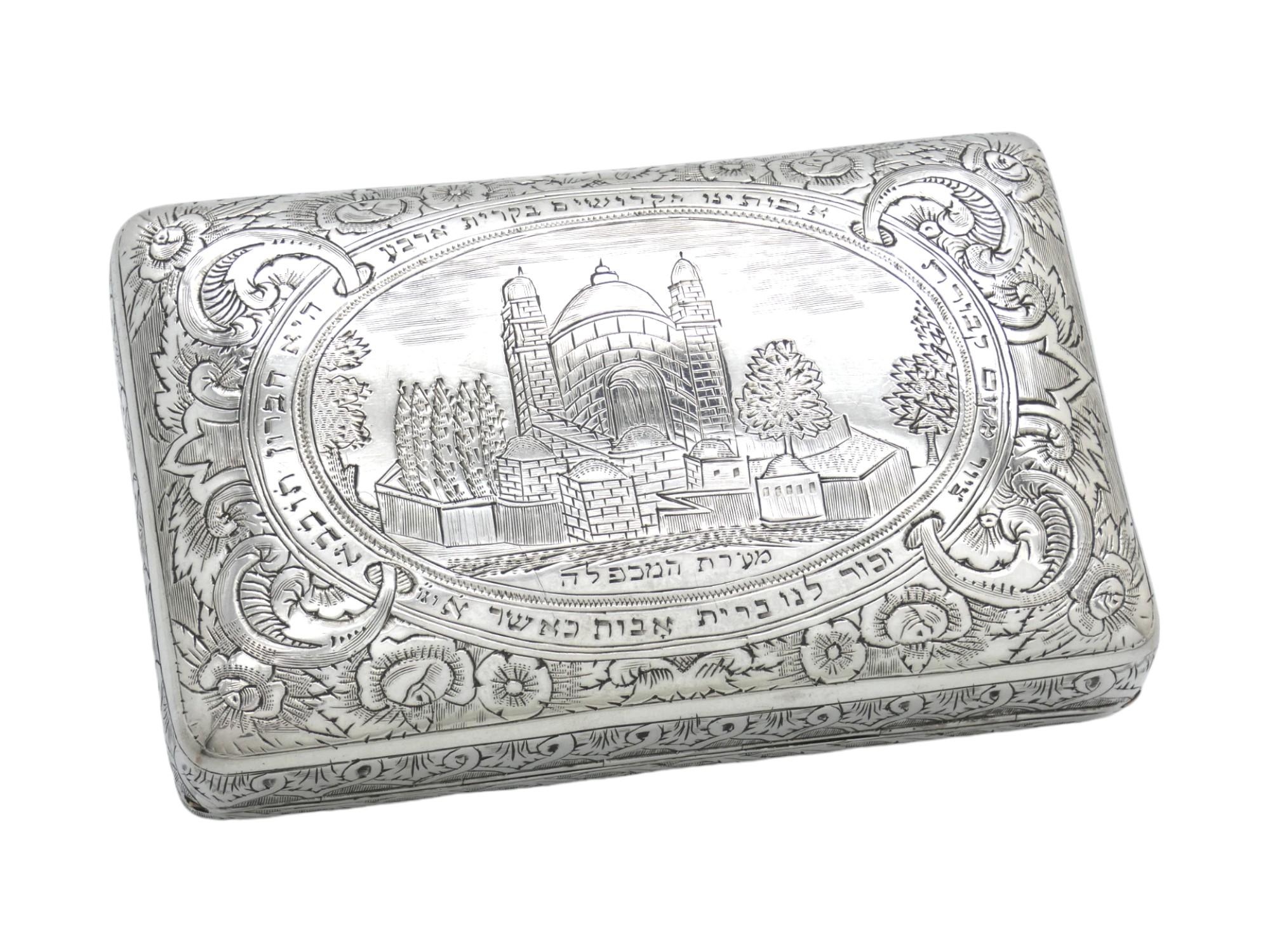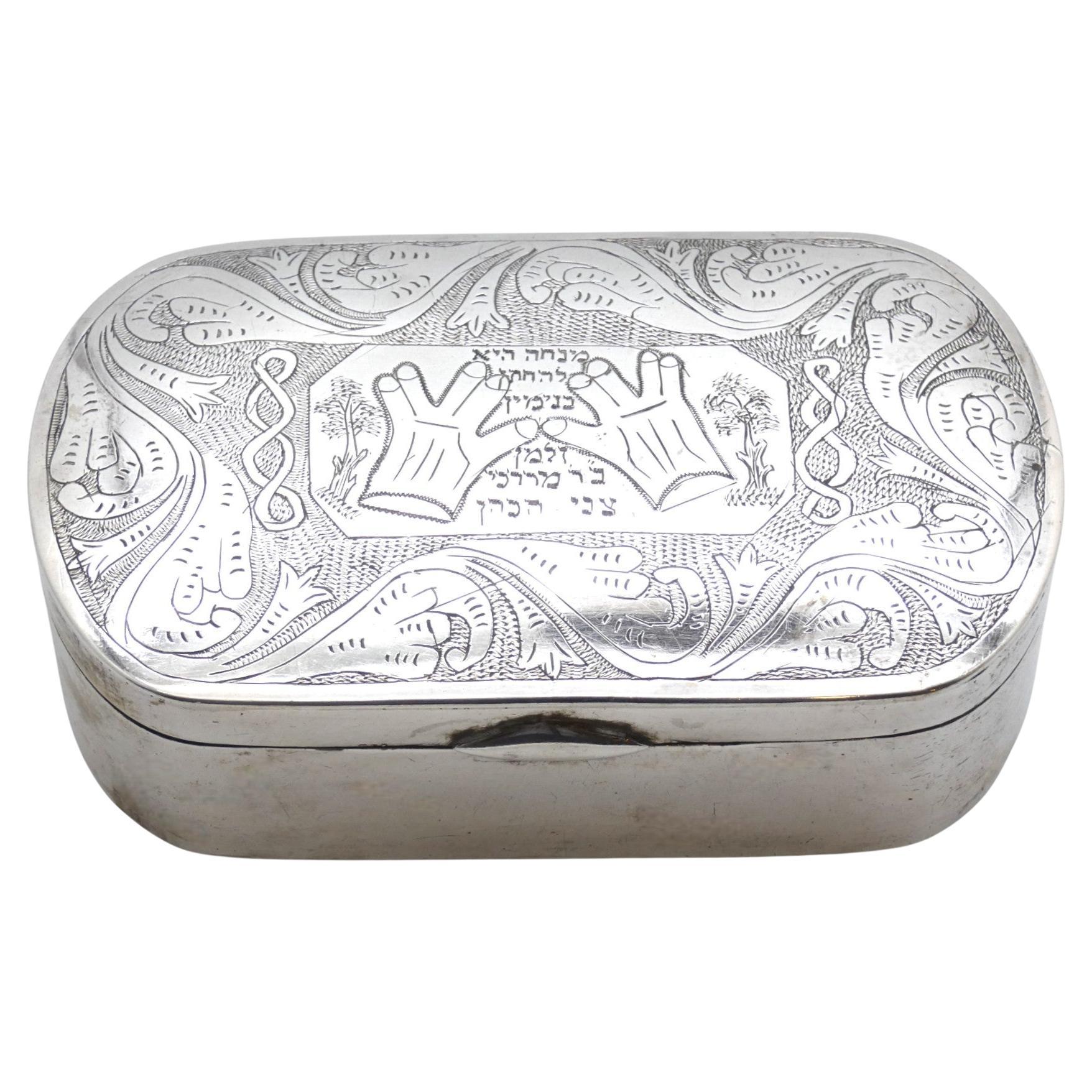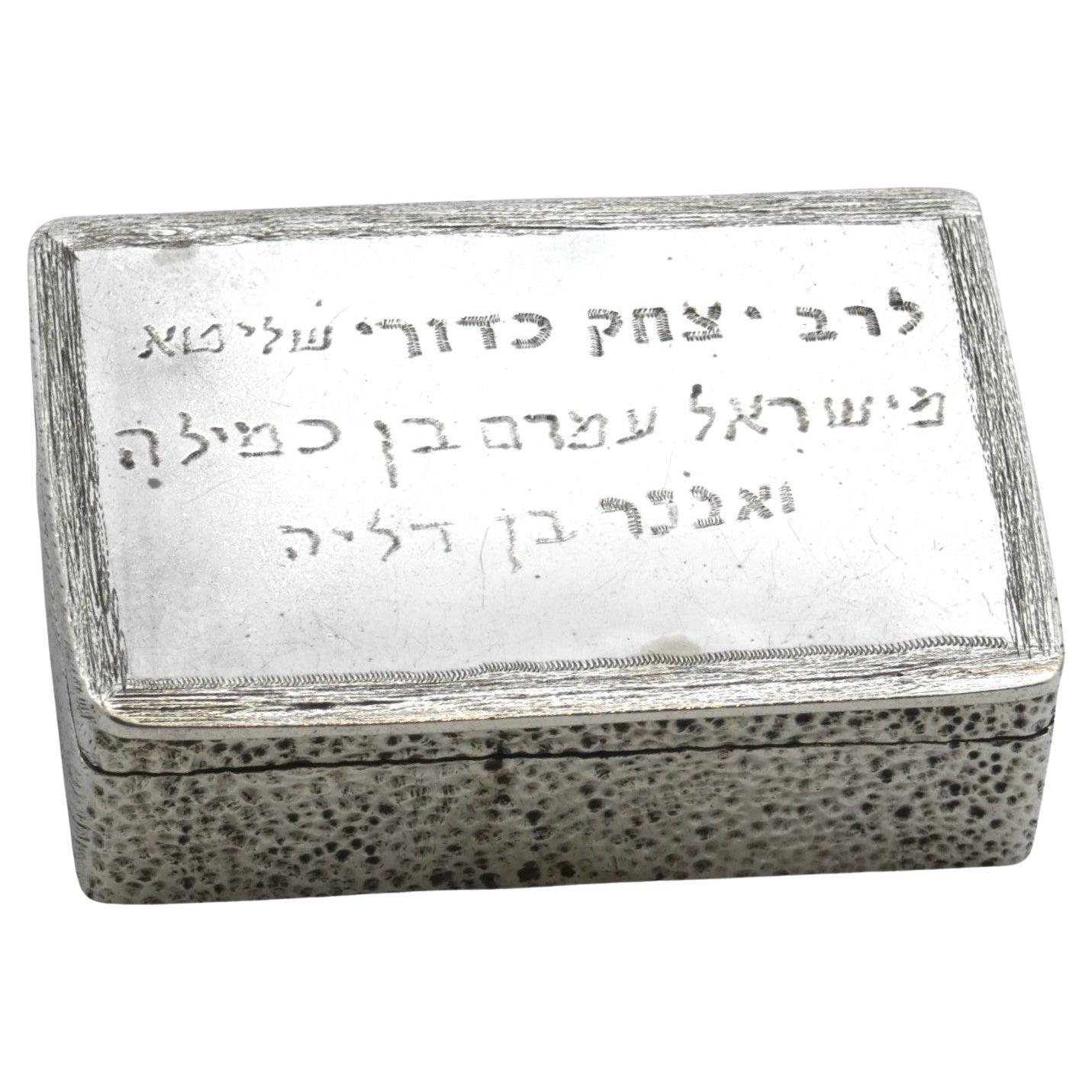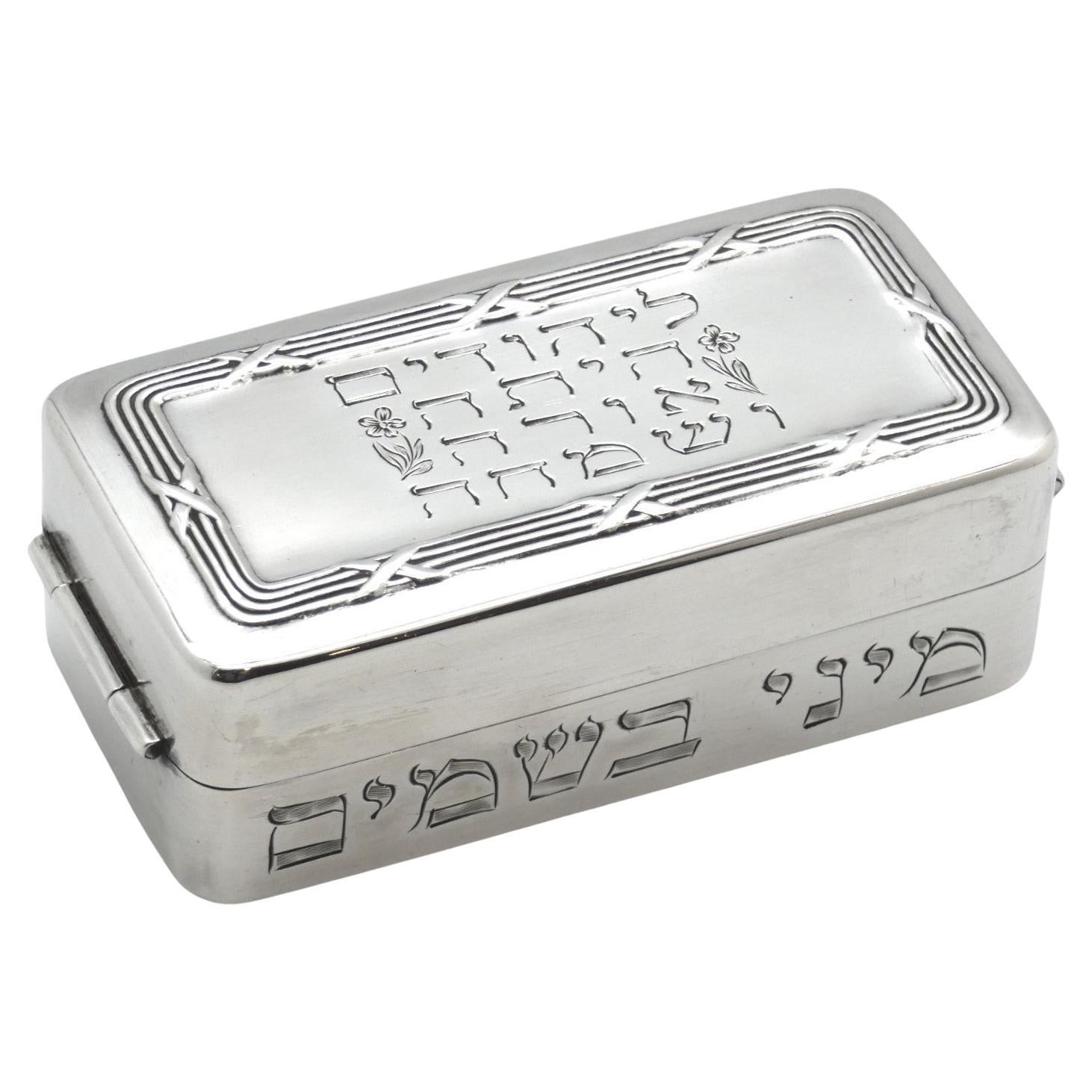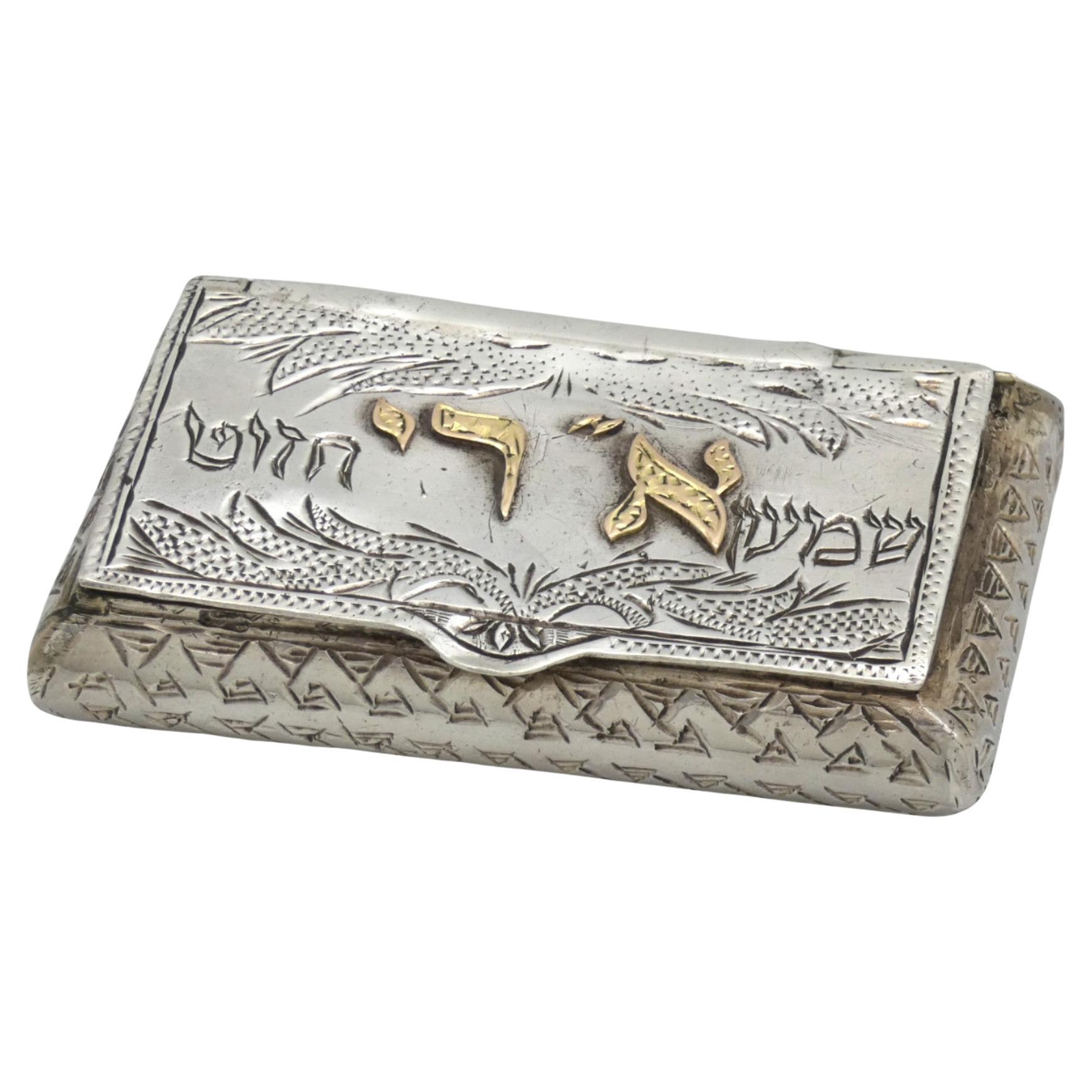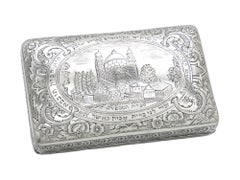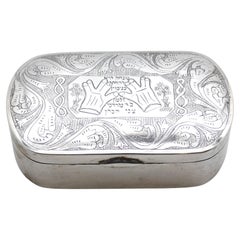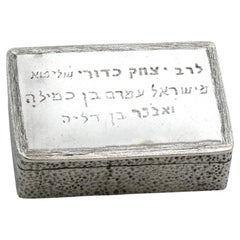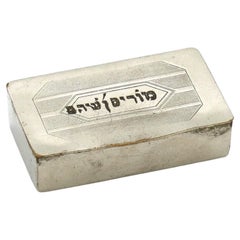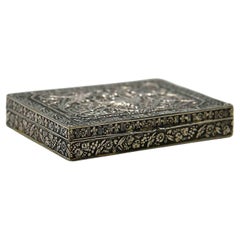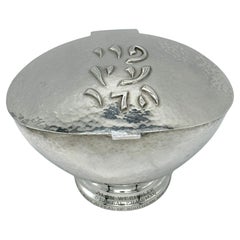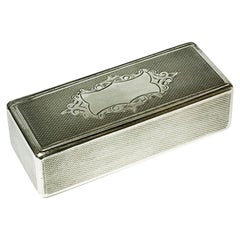Items Similar to An Engraved Pewter Snuff Box, Circa 1900 Judaica
Want more images or videos?
Request additional images or videos from the seller
1 of 9
An Engraved Pewter Snuff Box, Circa 1900 Judaica
$900
£686.66
€785.23
CA$1,268.29
A$1,382.94
CHF 733.91
MX$16,719.26
NOK 9,288.17
SEK 8,513.90
DKK 5,864.88
About the Item
This charming engraved pewter snuff box, dating to circa 1900, is a beautifully preserved example of everyday Judaica—a personal object once carried and cherished, now elevated by its artistry and cultural resonance.
Cast in a rectangular form with gracefully rounded upper and lower edges, the box features a hinged lid intricately adorned with delicate scrolled engravings. The flowing foliate patterns are arranged in a symmetrical design, framing a central gilt-toned plaque that provides both visual contrast and focal significance.
At the center of this plaque, carefully engraved in Hebrew script, appears the name of its original owner:
"אריה שתערענגאס" – Aryeh Shterengas.
The choice of pewter, a commonly used yet humble material, reflects the practicality and modest means of many Jewish communities in Eastern and Central Europe at the turn of the 20th century, while the personalized inscription and ornamentation imbue the piece with sentimental value and individual distinction.
Snuff boxes such as this served both a ritual-social function and a personal identity, often gifted or passed down through generations. The preservation of the name in Hebrew further deepens its Jewish historical context, offering a tangible link to its owner’s heritage and daily life.
A fine and evocative piece of vernacular Judaica, this snuff box stands as a testament to the artistry found in personal Jewish objects, as well as the cultural importance of preserving names and narratives within the fabric of Jewish material culture.
- Dimensions:Height: 0.79 in (2 cm)Width: 2.76 in (7 cm)Depth: 1.58 in (4 cm)
- Materials and Techniques:Pewter,Engraved
- Place of Origin:Poland
- Period:1900-1909
- Date of Manufacture:1900's
- Condition:Wear consistent with age and use.
- Seller Location:New York, NY
- Reference Number:1stDibs: LU5281245675952
About the Seller
5.0
Recognized Seller
These prestigious sellers are industry leaders and represent the highest echelon for item quality and design.
Established in 2006
1stDibs seller since 2020
150 sales on 1stDibs
Typical response time: 10 hours
- ShippingRetrieving quote...Shipping from: Pomona, NY
- Return Policy
More From This Seller
View AllA Fantastic Silver Snuff Box, Jerusalem late 19th Century. Hebrew judaica
Located in New York, NY
A beautifully engraved silver snuff box from Jerusalem from the late 19th century is finely crafted and is a piece that reflects the rich cultural heritage and craftsmanship of the r...
Category
Antique Late 19th Century Israeli Rococo Sterling Silver
Materials
Silver
A Large Silver Russian Snuff Box, Late 19th Century. Hebrew - Judaica
Located in New York, NY
This large Russian silver snuff box from the late 19th century is a finely crafted and substantial piece, reflecting the opulence and attent...
Category
Antique Late 19th Century Russian Sterling Silver
Materials
Silver
A Silver Snuff Box Belonging to the Holy Mekubal Harav Yitzchak Kaduri
Located in New York, NY
A Silver Snuff Box Belonging to the Holy Mekubal Harav Yitzchak Kaduri.
The Kabbalist Rabbi Yitzhak Kaduri was born at the end of the 19th Century in Iraq, studied Torah and Kabbala...
Category
20th Century Sterling Silver
Materials
Silver
An Egyptian Silver Plated Snuff Container by Chaim Kohen Tzabon, Circa 1930
Located in New York, NY
This Egyptian silver-plated snuff box, circa 1930, features a delicate silver-plated finish that reflects the artisanal craftsmanship of early 20th-century Egypt. The container is sm...
Category
Vintage 1930s Egyptian Sterling Silver
Materials
Silver Plate
A Silver German Havdalah Spice Box, Early 20th Century
Located in New York, NY
A silver German spice box from the early 20th century is a finely crafted, understated yet elegant piece that reflects the high level of craftsmanship typical of German silversmiths during this period.
The box is rectangular, with smooth silver surfaces and the design leans toward simplicity, characteristic of the early 20th century's shift toward Art Deco or late Jugendstil (German Art Nouveau) influences. The hinged lid features clean geometric patterns that frame the engraving written in Hebrew at the center flanked by flower engravings and securely closes over the compartment with a latch that holds the fragrant spices. The sides of the spice box are beautifully engraved with more Hebrew verses relating to the blessings of the spices and flanked by flower motifs. The overall structure is delicate yet sturdy, reflecting the precision and skill of early 20th-century German Judaica...
Category
Early 20th Century German Sterling Silver
Materials
Silver
A Silver and Gold Moroccan Snuff Box circa 1920
Located in New York, NY
A silver and gold Moroccan snuff box from circa 1920 is a stunning example of North African craftsmanship, blending traditional Berber and Islamic design...
Category
Vintage 1920s Moroccan Sterling Silver
Materials
Silver
You May Also Like
extremely rare Algerian Judaica silver, jewish Dowry box early 19th century
Located in Tel Aviv - Jaffa, IL
Amazing and scarce JUDAICA object, we have here one of the most touching jewish objects we had for a long time, this small silver dowry box was made in Algeria in the early 19th century, it is all covered with symbols of jewish faith and of couples, the sliding lid has 2 flanking birds with hamsa (protective hand) on each side and a flower vase in the middle.
one side shows two flanking lions with a tree in the middle and the other side shows again two big and two small birds with a flower bowl in the middle, front side has a key hole and next to it there is the Hebrew inscription ס״ט״" which says Siman tov or in English "a good sign" it is taken from the wedding blessing, underneath the lock there is another inscription with the name ״עזיזה בת אברהם בן חמו״ which is the name of the bride, her father and her grandfathers name.
the box is full marked a lot of times with the silversmith mark, every side of the box is marked.
this box was probably ordered by the grooms family to hold the jewelry they are giving to the bride as dowry, this type of objects are rare and there are just a few of them on museum collections.
DOWRY (Heb. נְדֻנְיָה), the property a wife brings to her husband at marriage; the Yiddish equivalent, nadn, is from the same root. The custom of nedunyah became clearly defined and institutionalized only in the talmudic period. In biblical times, mohar (מֹהַר), whereby the groom bought his wife from her father (Gen. 24:53; Ex. 22:15–16; Hos. 3:2), was the accepted practice. It was then customary that the groom give the bride gifts, and that she bring certain property to her husband's home upon marriage: slaves, cattle, real estate, etc. (cf. Gen. 24:59–61; 29; Judg. 1:14ff.; I Kings 9:16). Evidence of the custom of nedunyah is to be found in Tobit (7:14; 8:21) and in the Assuan papyri (Cowley, Aramaic, nos. 15, 18). Gradually, mohar was superseded by the ketubbah custom according to which the husband merely assumed the responsibility of compensation to his wife in case he divorced her: he had to pay her 200 zuzim if she had been a virgin at the time of marriage, and 100 zuzim if a widow or divorcée (see *Ketubbah).
By talmudic times, the institution of nedunyah was prevalent; the father gave a dowry to the bride since the daughter was excluded from paternal inheritance. Fifty zuzim (equivalent to the worth of 180 grams of silver) was the minimum amount a father was obliged to give to his daughter (Ket. 6:5). Parents usually gave much more, according to their social standing. Community funds provided the dowry for an orphan or a very poor girl (ibid.; cf. Sh. Ar., YD 251:8). In case of her father's death, the brothers of a minor girl were obliged to give her the minimum dowry, and the court estimated how much her father would have given her above the minimum dowry. The sum was then taken out of the father's estate and given to the daughter upon majority (Ket. 6:6; 68a–69b). In the absence of such an estimate, each daughter was entitled to receive one-tenth of the value of her father's estate in money, or in valuables (Yad, Ishut, 20:4–7; Sh. Ar., EH 113:4). If the father was unable or unwilling to pay the promised dowry at the betrothal ceremony, the groom could refuse to marry his bride (Ket. 13:5; Ket. 108b–109a). Insistence on exact payment of the promised dowry, however, was frowned upon by later rabbinic authorities (Rema to Sh. Ar., EH 2:1). In certain communities it was customary for the groom's father to make a dowry contribution equal to that of the bride's father (Ket. 102b). The dowry, whether given in real estate, slaves, money, or chattel was recorded in the marriage contract (the ketubbah) and in some instances one-third or one-fifth of the actual value of the dowry was added to the sum mentioned in the ketubbah. Based upon a decree enacted by *Simeon b. Shetah (first century C.E.), the Talmud ruled that the husband and his entire property were liable for compensation as stipulated in the ketubbah, either in case he died (when she collected the sum specified in the ketubbah from the heirs) or in case he divorced his wife (Ket. 82b). For the status of the dowry and the husband's rights and obligations, see below. The rabbinic enactments (Takkanot Shum) by R. Jacob *Tam and by the rabbinic synod of the communities of Speyer, Worms, and Mainz (Germany) stipulated that if a woman died...
Category
Antique Mid-19th Century Algerian Tribal Art
Materials
Silver
Fine Silver Snuff Box, Early 20th Century
Located in Roma, IT
A superb rectangular silver snuff box, masterfully crafted in in the early 20th century, featuring exquisitely chased and repoussé decoration. The hinged lid is richly adorned with s...
Category
Early 20th Century Italian Decorative Boxes
Materials
Silver
JUDAICA SILVER ETROG BOX DESIGNED BY LUDWIG WOLPERT. New York, 20th century
Located in Tel Aviv - Jaffa, IL
This charming piece of jewish history in front of you is a one of kind modern Judaica object,
This box used to hold the Etrog To protect the it during the holiday of Sukkot, it is traditionally Wrapped in silky flax fibers and stored in a special decorative box, mostly made from silver.
Wolpert designed this amazing hand hammered Bauhaus style box in 1963-1964 while he was Working in New York. all of the boxes we could found from this design made by Wolpert have The upper part inscribed in a simple engraving with the phrase "Pri Etz Hadar"
In Hebrew ״פרי עץ הדר״. the box in front of you is the only example in existence as far as we Know where the letters are also repoussé and also engraved, such a beautiful and hard to get Combination, the rest of the box is shaped as a modernistic Etrog, all the body of the box is Skillfully hand hammered in a way it reflects the light in a warm and calm way, a true Masterpiece of modern judaica by the great and important artist Ludwig Yehuda Wolpert.
One of the the two great masters of 20th century Judaica.
the Box is marked "WOLPERT" AND "STERLING" and the base has the engraved inscription :
"ALAN WECHSLER GENERAL CHAIRMAN, ALLIED JEWISH APPEAL OF SOUTHERN NEW JERSEY 1978"
Similar boxes can be find in museum collections around the world
In the Jewish Museum New York
In the North Carolina Museum of Art
In The Derfner Judaica Museum
Another similar box was featured in the Israel Museum exhibition
"Forging Ahead, Wolpert and Gumbel, Israeli Silversmiths for the Modern Age"
Ludwig Yehuda Wolpert was born in Hildesheim, Germany, to an Orthodox family. In 1916-1920, He began his studies in sculpture at the Frankfurt School of Art. In 1925-1928, he studied Goldsmithing at the Frankfurt School of Art.
Following the presentation of the works in the 1930 exhibition "Kult und Form" ("Ritual and Form") at the Jewish Museum in Berlin, his works became well known in the German Jewish World. His works were greatly influenced by Modernist design, especially the Bauhaus Movement. Wolpert's works avoid decoration, relying on clean, geometric shapes. In 1933, Following the Nazi rise to power in Germany, he immigrated to the Mandatory Palestine with His family. There he worked for two years in the workshop of Bernhard Friedländer, where he Designed and produced silverware and Jewish ceremonial art.Together with Victor Solomon...
Category
Vintage 1960s Decorative Boxes
Materials
Silver
19th Century French Silver Snuff Box
Located in Delft, NL
19th century French silver snuff box
Late 19th century silver snuffbox with engraved centre and gilt interior
Hall marked by the Silversmith, Dubois Leon & Bauve Henri
The Dutch...
Category
Antique 19th Century French Snuff Boxes and Tobacco Boxes
Materials
Silver
Gorham Silver Snuff Box from Mid-19th Century
By Gorham
Located in New York, NY
Gorham silver snuff box from the mid-19th century, gilt inside, with beautifully diapered and geometric designs. It measures 3 1/8'' in depth by 1 7/8'' in width by 7/8'' in height, ...
Category
Antique Mid-19th Century American Decorative Boxes
Materials
Silver
Antique Sterling Silver Snuff Box with Floral Motif
Located in Vienna, AT
This beautiful snuff box is made from sterling silver. Its inside is gold plated. Lid and bottom are covered in the same floral design reminiscent of a bouquet or floral ornament. Th...
Category
Antique Early 19th Century Austrian Empire Tobacco Accessories
Materials
Gold Plate, Sterling Silver
More Ways To Browse
Jewish Antique
Antique Hebrew
Antique Judaica
Engraved Pewter
Pewter Snuff Box
Antique Pewter Snuff Box
Antique Opium Box
Gold And Diamond Snuff Box
Italian Gold Snuff Boxes
Antique Bilston Enamel Boxes
Antique Chinese Snuff Boxes
Antique Papier Mache Snuff Box Snuff Boxes
Russian Cigarette
Silver Snuff Box German
Majolica Tobacco Jar
Russian Cigarette Case
Wooden Tobacco Box
18th Box Battersea
